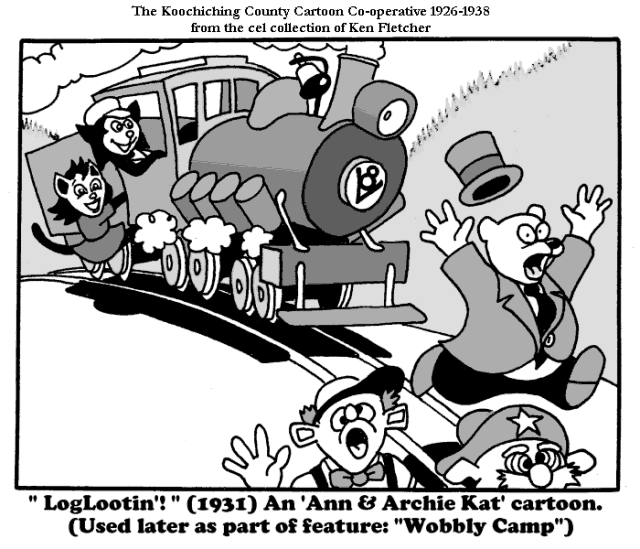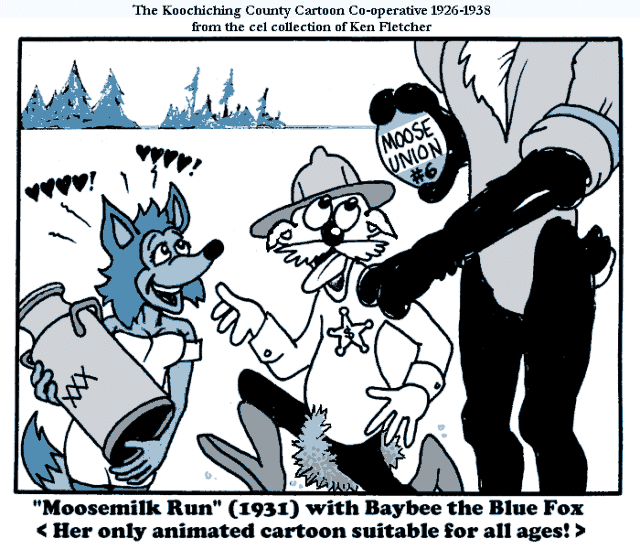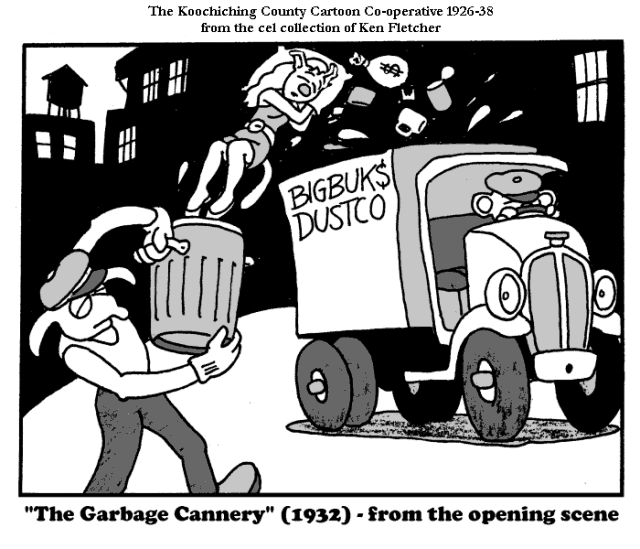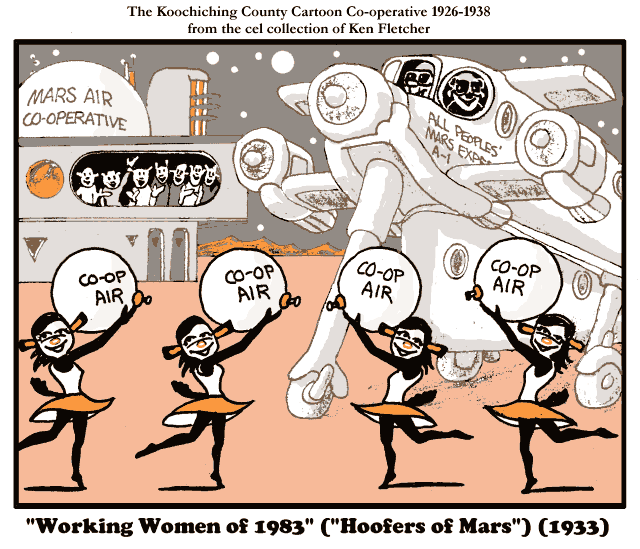Images from cartoons you might see
at a Spontoon Island Movie Theater in the 1930s.
- Cels from the collection of Ken Fletcher -

Spontoon Island
home
- contact - credits
- new - links -
history
- maps - art -
story
comic
strips - editorial - souvenirs - Yahoo forum
Updated: 10
January 2011 - link to Baybee, the Blue Fox
page (mature)
* Update 18 April 2013: Baybee, the Blue Fox page (mature) *
* (art via O.T. Grey - essay by 'A. Kinoyev') *

|
Animated Cartoons of the Koochiching County Cartoon Co-Operative (1926-1938) by A. Kinoyev, movie critic to The Island Birdwatcher The original studio floated around in various locations in northern Minnesota, not usually in Koochiching County, but actually more often in upstairs offices in populist-tolerant small towns in the Minnesota Iron Range country. The KCCC members claimed this was to be close to a supply of their primary animation materials: tracing paper. Most of the original cartoons were low-budget and low- tech. Instead of nitrate celluloid, the animators did the animation sequences on tracing paper, which was punched for alignment pins, worked up on light tables, and photographed in the usual way. This gave the early cartoons a unique "look", especially with the backgrounds toned by the translucent tracing paper of the cels. The KCCC produced at least 35 cartoons, two 2-reel 'features', and one 3-reel 'feature'. The animations were silent and in black & white (except for 3 of the Baybee the Blue Fox cartoons, that used a limited blue-tone color process, and the strangely orange-tinted "Working Women of 1983", also known as "Hoofers of Mars"). The KCCC cartoons had sub-texts of the obvious anarchist and left-wing flavor, but were intended to suceed as broad entertainment for the working classes. Enough of the cartoons found their audience. The stories were considered funny, if somewhat coarse, and certainly had a unique point of view, being willing to make some low-key (and sometimes low-class) social commentary. In some regions of the USA they actually achieved some popular culture notoriety in the late 1920s and early 30s era of "inkblot" cartoons. The films were intended to be low-cost and profitable, and usually used alternate film distributors in the United States, or were distributed outside of the regular movie theater chains. They were often shown as part of entertainment programs in social halls. The KCCC scraped by with the USA profits. The KCCC animations were considerably better distributed and more profitable outside of the United States, with circulation through leftist political networks and movie programs at political halls. The studio did not always get their share of profits, though. Obviously, there would be problems with censorship. They were not considered particularly uplifting or Stalinist-friendly in some political circles. A few of the cartoons would now be considered X-rated, even though they were allegedly 'educational' in theme. Their cartoon sub-texts in general were certainly frowned-upon by censorship boards. By 1931, there was considerable pressure to get the KCCC films out of circulation in the United States. Under this pressure, the core group of the co-operative first moved their studios to Canada, and then to the Rain Coast by 1933, where the co-op & syndicalist culture was a good fit (for a while). The KCCC had influenced the small animation syndicates working in the Rain Coast, and were welcomed. It may have been too much of a relief and too comfortable. Animation technology and the expectations of audiences made the KCCC silent black-and-white animations more anachronistic, even for a world market. The animators started to disperse to other of the art syndicates, and the reminant KCCC voted to join the largest Rain Island animation syndicate in 1938. By the mid-30s the KCCC animations were being pirated, most notably by Russian animation studios. The Russians sometimes would redo them in standard color cel animation, with musical tracks (sound-on-film), and a few dubbed with dialog. The story lines and political messages were quite often edited. If you have seen a color "KCCC" cartoon, this is probably where it comes from, one of the Russian unauthorized upgrades. The KCCC erotic animations have often been pirated and re-edited over the years, and you can see sequences incorporated (out of context) into other "blue-movie" animations. Spontoon Island (or its cartooned archtype) appeared in at least 4 of the KCCC cartoons, as the small tropical "worker's paradise" became well known in popular culture by the late 1920s. A. Kinoyev (Filmography to follow) |


